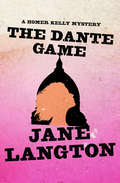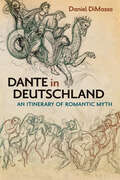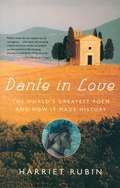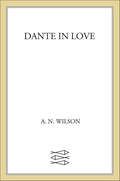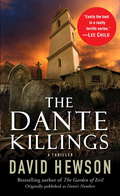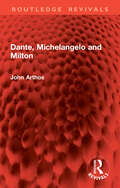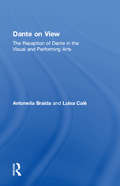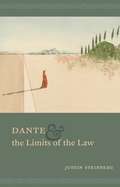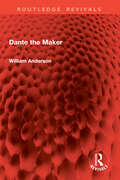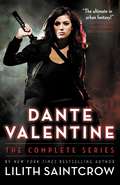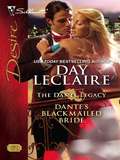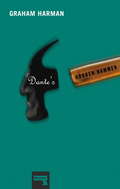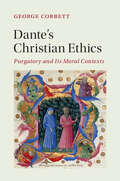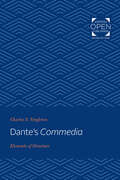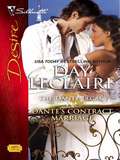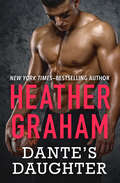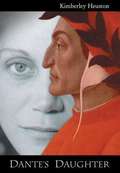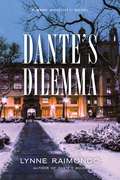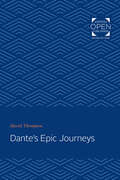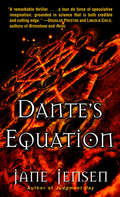- Table View
- List View
The Dante Game (The Homer Kelly Mysteries #Bk. 8)
by Jane LangtonIn Florence, scholar/sleuth Homer Kelly must foil a plot to kill the Pope in a &“voluptuously detailed&” mystery in which Langton&’s &“exuberant wit runs riot&” (The New York Times Book Review). When the Pope issues a sweeping edict calling for a yearlong war on drugs, no one is more surprised than the Vatican to find the campaign a success. In every Catholic corner of the world, young people throw down their needles to pick up crosses. In Florence, thousands of them converge on the Duomo to thank Christ for their newfound commitment to sobriety. Nearly everyone is relieved by this development—save for Leonardo Bindo, banker and druglord. To get his business back on track, he seizes upon a simple plan: Kill the Pope. Standing in his way is Homer Kelly, transcendentalist scholar and occasional detective. In Florence to teach at a new international university, Homer stumbles on Bindo&’s scheme while investigating the disappearance of a beautiful young student. His Italian may be lousy, but Homer is the only man who can save Italy from itself.
Dante in Context
by Zygmunt G. BarańskiIn the past seven centuries Dante has become world renowned, with his works translated into multiple languages and read by people of all ages and cultural backgrounds. This volume brings together interdisciplinary essays by leading, international scholars to provide a comprehensive account of the historical, cultural and intellectual context in which Dante lived and worked: from the economic, social and political scene to the feel of daily life; from education and religion to the administration of justice; from medicine to philosophy and science; from classical antiquity to popular culture; and from the dramatic transformation of urban spaces to the explosion of visual arts and music. This book, while locating Dante in relation to each of these topics, offers readers a clear and reliable idea of what life was like for Dante as an outstanding poet and intellectual in the Italy of the late Middle Ages.
Dante in Deutschland: An Itinerary of Romantic Myth (New Studies in the Age of Goethe)
by Daniel DiMassaAround the turn of the nineteenth century, no task seemed more urgent to German Romantics than the creation of a new mythology. It would unite modern poets and grant them common ground, and bring philosophers and the Volk closer together. But what would a new mythology look like? Only one model sufficed, according to Friedrich Schlegel: Dante’s Divine Comedy. Through reading and juxtaposing canonical and obscure texts, Dante in Deutschland shows how Dante’s work shaped the development of German Romanticism; it argues, all the while, that the weight of Dante’s influence induced a Romantic preoccupation with authority: Who was authorized to create a mythology? This question—traced across texts by Schelling, Novalis, and Goethe—begets a Neo-Romantic fixation with Dantean authority in the mythic ventures of Gerhart Hauptmann, Rudolf Borchardt, and Stefan George. Only in Thomas Mann’s novels, DiMassa asserts, is the Romantics’ Dantean project ultimately demythologized.
Dante in Love: The World's Greatest Poem and How It Made History
by Harriet RubinDante in Love is the story of the most famous journey in literature. Dante Alighieri, exiled from his home in Florence, a fugitive from justice, followed a road in 1302 that took him first to the labyrinths of hell then up the healing mountain of purgatory, and finally to paradise. He found a vision and a language that made him immortal. Author Harriet Rubin follows Dante's path along the old Jubilee routes that linked monasteries and all roads to Rome. It is a path followed by generations of seekers -- from T. S. Eliot, Sigmund Freud, Primo Levi, to Bruce Springsteen. After the poet fled Rome for Siena he walked along the upper Arno, past La Verna, to Bibiena, to Cesena, and to the Po plain. During his nineteen-year journey Dante wrote his "unfathomable heart song," as Thomas Carlyle called The Divine Comedy, a poem that explores the three states of the psyche. Eliot, a lifelong student of the Comedy, said, "Dante and Shakespeare divide the modern world between them, there is no third. "Dante in Love tells the story of the High Middle Ages, a time during which the artist Giotto was the first to paint the sky blue, Francis of Assisi discovered knowledge in humility and the great doctors of the church mapped the soul and stood back to admire their cathedrals. Dante's medieval world gave birth to the foundation of modern art, faith and commerce. Dante and his fellow artists were trying to decode God's art and in so doing unravel the double helix of creativity. We meet the painters, church builders and pilgrims from Florence to Rome to Venice and Verona who made the roads the center of the medieval world. Following Dante's route, we are inspired to undertake journeys of discovering ourselves. In the vein of Brunelleschi's Dome, Galileo's Daughter and Wittgenstein's Poker, Dante in Love is a worldly and spiritual travelogue of the poet's travels and the journey of creativity that produced the greatest poem ever written.
Dante in Love: A Biography
by A. N. WilsonFor William Butler Yeats, Dante Alighieri was "the chief imagination of Christendom." For T. S. Eliot, he was of supreme importance, both as poet and philosopher. Coleridge championed his introduction to an English readership. Tennyson based his poem "Ulysses" on lines from the Inferno. Byron chastised an "Ungrateful Florence" for exiling Dante. The DivineComedy resonates across five hundred years of our literary canon. In Dante in Love, A. N. Wilson presents a glittering study of an artist and his world, arguing that without an understanding of medieval Florence, it is impossible to grasp the meaning of Dante's great poem. He explains how the Italian states were at that time locked into violent feuds, mirrored in the ferocious competition between the Holy Roman Empire and the Papacy. He shows how Dante's preoccupations with classical mythology, numerology, and the great Christian philosophers inform every line of the Comedy. Dante in Love also explores the enigma of the man who never wrote about the mother of his children, yet immortalized the mysterious Beatrice whom he barely knew. With a biographer's eye for detail and a novelist's comprehension of the creative process, A. N. Wilson paints a masterful portrait of Dante Alighieri and unlocks one of the seminal works of literature for a new generation of readers.
The Dante Killings (Nic Costa #7)
by David HewsonOn a warm, golden evening in Rome, celebrities and paparazzi gather at the Villa Borghese as a legendary director premieres his long-anticipated film version of Dante's Inferno. But minutes later the scene is chaos: A man lies dead, the film's star is missing, and a priceless relic has vanished. As the premiere shifts locations--from Rome to San Francisco--detective Nic Costa finds himself on U.S. shores for the first time, charged with protecting a trove of rare Italian artworks and artifacts, as well as an American film actress, Maggie Flavier. When a killer indeed strikes, and with Flavier in danger, Costa races to unravel the chilling clues that connect Dante's nine circles of Hell to the shattering revelations of Alfred Hitchcock's Vertigo. But he may be too late. For a cunning plot is closing in around Costa, guided by a poet's ancient vision of sin and punishment and a killer's genius for terror. Previously published as Dante's Numbers.From the Paperback edition.
Dante, Michelangelo and Milton (Routledge Revivals)
by John ArthosOriginally published in 1963, this is a study of the greatness of Dante, Michelangelo and Milton, and of the differences in the power and effect of their work. This book shows how differing philosophical commitments help explain differences in the character of their greatness. The ancient treatise On the Sublime provides the starting point for these studies and in an introductory essay the author examines Longinus’ obligations to Platonic and Stoic philosophy. In the essays which relate the critical doctrines of Dante, Michelangelo and Milton to philosophy, he shows how far their thought accords with Longinus’ and to what degree they depend upon the same philosophic traditions. The final emphasis, however, is upon the relation of their ideas to the distinctive elements of their greatness.
Dante on View: The Reception of Dante in the Visual and Performing Arts
by Antonella Braida Luisa CalèDante on View opens an important new dimension in Dante studies: for the first time a collection of essays analyses the presence of the Italian Medieval poet Dante Alighieri in the visual and performing arts from the Middle Ages to the present day. The essays in this volume explore the image of Dante emerging in medieval illuminated manuscripts and later ideological and nostalgic uses of the poet. The volume also demonstrates the rich diversity of projects inspired by the Commedia both as an overall polysemic structure and as a repository of scenes, which generate a repertoire for painters, actors and film-makers. In its original multimediality, Dante's Commedia stimulates the performance of readers and artists working in different media from manuscript to stage, from ballet to hyperinstruments, from film to television. Through such a variety of media, the reception of Dante in the visual and performing arts enriches our understanding of the poet and of the arts represented at key moments of formal and structural change in the European cultural world.
Dante & the Limits of the Law
by Justin SteinbergIn Dante and the Limits of the Law, Justin Steinberg offers the first comprehensive study of the legal structure essential to Dante’s Divine Comedy. Steinberg reveals how Dante imagines an afterlife dominated by sophisticated laws, hierarchical jurisdictions, and rationalized punishments and rewards. He makes the compelling case that Dante deliberately exploits this highly structured legal system to explore the phenomenon of exceptions to it, crucially introducing Dante to current debates about literature’s relation to law, exceptionality, and sovereignty. Examining how Dante probes the limits of the law in this juridical otherworld, Steinberg argues that exceptions were vital to the medieval legal order and that Dante’s otherworld represents an ideal “system of exception.” In the real world, Dante saw this system as increasingly threatened by the dual crises of church and empire: the abuses and overreaching of the popes and the absence of an effective Holy Roman Emperor. Steinberg shows that Dante’s imagination of the afterlife seeks to address this gap between the universal validity of Roman law and the lack of a sovereign power to enforce it. Exploring the institutional role of disgrace, the entwined phenomena of judicial discretion and artistic freedom, medieval ideas about privilege and immunity, and the place of judgment in the poem, this cogently argued book brings to life Dante’s sense of justice.
Dante the Lyric and Ethical Poet: Dante Lirico E Etico
by Zygmunt G. Bara'nski"This book presents the proceedings of the fifth meeting of the International Dante Seminar. As with previous volumes, the proceedings also include a carefully edited account of the extensive discussions which followed the presentations. The papers, given by some of the leading international scholars of the poet - from Italy, the UK and the USA - address four major topics of particular concern to present-day Dante studies: Dante as a lyric poet; Dante as an ethical poet; Dante and the Eclogues; and Dante in nineteenth-century Britain. These topics reflect both areas which are currently the subject of heated critical debate (several editions of the lyric poems are in preparation, and the ethical dimension of Dantes works is very much under discussion) and areas which are long overdue a reassessment (Dantes remarkable revival of Latin pastoral poetry, and the extraordinary British contribution to Dante studies in the nineteenth century). As this set of conference proceedings makes clear, in Dante and in his legacy, ethics and poetry are inseparable. The contributors include Paola Allegretti, Michael Caesar, Paolo Falzone, Manuele Gragnolati, Claudio Giunta, Claire Honess, Robin Kirkpatrick, John Lindon, Lino Pertile, Justin Steinberg, Claudia Villa, and Diego Zancani."
Dante the Maker (Routledge Revivals)
by William AndersonFirst published in 1980, Dante the Maker examines the great Italian poet’s creative processes and presents a wider perspective on Dante. Divided into three major parts, it discusses themes like the making of a poet; power exile and the works of Dante’s middle years; and the making of the Commedia. The book allows Anderson to explore the relevant political backgrounds, historical context, aesthetic, philosophical and even scientific currents- and the events of Dante’s own life - and finally to give his own judgement on how these diverse forces impinged on the poet’s creative processes. This literary biography is a must read for scholars and researchers of Literature.
Dante Valentine: The Complete Series (Dante Valentine)
by Lilith SaintcrowNecromancer. Bounty hunter. Killer.Dante Valentine has been all three in her life. But in the beginning, she was a Necromancer for hire. And while she was choosy about her jobs, there were just some she couldn't turn down. Like when the Devil showed up at the door and offered her a deal. Her life - in exchange for the capture and elimination of a renegade demon. But how do you kill something that can't die?Dante Valentine, one of urban fantasy's hottest series, is compiled into one volume for the first time. Included in this omnibus edition are: Working for the Devil, Dead Man Rising, The Devil's Right Hand, Saint City Sinners, and To Hell and Back.
Dante Valentine: A Dante Valentine Novel (Dante Valentine Novels #2)
by Lilith SaintcrowNecromancer. Bounty hunter. Killer.Dante Valentine has been all three in her life. But in the beginning, she was a Necromancer for hire. And while she was choosy about her jobs, there were just some she couldn't turn down - like when the Devil showed up at the door and offered her a deal. Her life - in exchange for the capture and elimination of a renegade demon. But how do you kill something that can't die?This omnibus edition contains these titles: Workng for the Devil, Dead Man Rising, The Devil's Right Hand, Saint City Sinners and To Hell and Back.
Dantean Dialogues
by Margaret Maggie Kilgour Elena LombardiDantean Dialogues is a collection of essays by some of the most outstanding Dante scholars., These essays enter into conversation with the main themes of the scholarship of Amilcare Iannucci (d. 2007), one of the leading researchers on Dante of his generation and arguably Canada's finest scholar of the Italian poet.The essays focus on the major themes of Iannucci's work, including the development of Dante's early poetry, Dante's relation to classical and biblical sources, and Dante's reception. The contributors cover crucial aspects of Dante's work, from the authority of the New Life to the novelty of his early poetry, to key episodes in the Comedy, to the poem's afterlife. Together, the essays show how Iannucci's reading of central cruxes in Dante's texts continues to inspire Dante studies - a testament to his continuing influence and profound intellectual legacy.
Dante's Blackmailed Bride
by Day LeclaireJump into the fire Severo Dante and his brothers had always dismissed rumors of the Inferno--an explosive desire that overtakes Dante men when they first see their soul mates. Then Severo met jewelry designer Francesca Sommers and was astonished by their raw, urgent, mutual attraction. A rising star at a rival company, Francesca has crafted a dazzling new collection that could ruin Severo's plans to rebuild the Dante empire. His solution: blackmail her into becoming his employee--and his fiancÉe--until their smoldering affair runs its course. But some fires, once lit, can never be extinguished. . . .
Dante's Broken Hammer
by Graham HarmanIn this book the founder of object-oriented philosophy transforms one of the classic poets of the Western canon, Dante Alighieri, into an edgy stimulus for contemporary continental thought. It is well known that Dante's poetic works interpret love as the moving force of the universe: as embodied in his muse Beatrice from La Vita Nuova onward, as well as the much holier persons inhabiting Paradiso. Likewise, if love is the ultimate form of sincerity, it is easy to interpret the Inferno as a brilliant counterpoint of anti-sincerity, governed by fraud and blasphemy along with the innocuous form of fraud known as humor (strangely absent from all parts of Dante's cosmos other than hell). In turn, the middle ground of Purgatorio is where Harman locates Dante's clearest theory of sincerity. Yet this is only the beginning. For while Dante provides a suitable background for the metaphysics of commitment found in such later thinkers as Pascal, Kierkegaard, Sartre, and Badiou, he also provides even more important resources for overcoming two centuries of philosophy shaped by Immanuel Kant.From the Trade Paperback edition.
Dante's Christian Ethics: Purgatory and its Moral Contexts (Cambridge Studies in Medieval Literature #110)
by George CorbettThis book is a major re-appraisal of the Commedia as originally envisaged by Dante: as a work of ethics. Privileging the ethical, Corbett increases our appreciation of Dante's eschatological innovations and literary genius. Drawing upon a wider range of moral contexts than in previous studies, this book presents an overarching account of the complex ordering and political programme of Dante's afterlife. Balancing close readings with a lucid overview of Dante's Commedia as an ethical and political manifesto, Corbett cogently approaches the poem through its moral structure. The book provides detailed interpretations of three particularly significant sins - pride, sloth, and avarice - and the three terraces of Purgatory devoted to them. While scholars register Dante's explicit confession of pride, the volume uncovers Dante's implicit confession of sloth and prodigality (the opposing subvice of avarice) through Statius, his moral cypher.
Dante's Commedia: Elements of Structure
by Charles S. SingletonOriginally published in 1977. This book contains four essays by Professor Charles Singleton: "Allegory," "Symbolism," "The Pattern at the Center," and "The Substance of Things Seen." These four essays treat four dimensions of meaning essential to understanding the substance and special texture of the poetry of the Divine Comedy. One might speak of "facets" or "aspects" of meaning if such terms did not suggest surface reflections dependent on the way a work (as a jewel) is turned for inspection. But for Singleton, each dimension has a depth that reaches to the core and substance of Dante's poetry, so they are, in Singleton's view, elements of its structure.
Dante's Contract Marriage
by Day LeclaireWealthy businessman Lazzaro Dante was far too sophisticated to believe in the legend of the Dante Inferno. So he was certain that a marriage of convenience, to protect his family's claim to a priceless diamond, would leave his heart untouched. But from the first moment he met Ariana Romano, his very soul was seared by a desire unlike any he had ever known. And despite their secret agreement to make theirs a marriage in name only, he knew the passion that blazed between them could not be kept hidden for long. . . .
Dante's Daughter
by Heather GrahamHearts collide when the daughter of a former football pro must interview her greatest rival Aspiring journalist Katie Hudson, daughter of the late Hall of Famer Dante Hudson, knows everything there is to know about football. Her editor is convinced that Katie can work her family connections to get an in-depth interview with Kent Hart, the elusive superstar receiver of the Sarasota Saxons, a team on the verge of going to the Super Bowl. Though Kent has always idolized Katie&’s father—a man he considers to be his mentor—she has harbored resentment toward Kent for years. Swallowing her pride isn&’t easy when the ghost of the man they both loved stands between them. Katie is dogged, but what will happen when she discovers a new side to the man she thought she knew? This ebook features an illustrated biography of Heather Graham including rare photos from the author&’s personal collection.
Dante's Daughter
by Kimberley HeustonHistorian Heuston has meticulously researched the life and times of 14th-century poet Dante in order to create this fictional account of the great poet's daughter, Beatrice, in the decades preceding the Italian Renaissance.
Dante's Dilemma: A Mark Angelotti Novel (Mark Angelotti)
by Lynne RaimondoBlind psychiatrist Mark Angelotti is faced with his most troubling case yet when he is asked to evaluate Rachel Lazarus, the estranged wife of a slain University of Chicago professor. Months earlier, the professor's body was found stuffed into one of the exhibits at "Scav," the school's world-famous annual scavenger hunt, and - in a feast for the press - missing a vital piece of its anatomy. Though she's confessed to her husband's murder, Rachel is mounting a battered woman's defense. Forced into helping the prosecution, Mark becomes unsure of his objectivity when his investigation uncovers uncomfortable parallels between Rachel's history and his own. That concern proves well-founded when his damaging admission at trial all but convicts Rachel. Then a tip connects the case to another suspected murder and evidence that Rachel may not be guilty after all. As he plows ahead during a brutal Chicago winter, Mark soon learns he has far more to worry about than treacherous snow and ice: someone will do anything to guarantee that Rachel takes the fall. From the Trade Paperback edition.
Dante's Divine Comedy: A Biography
by Joseph LuzziThe life and times of Dante&’s soaring poetic allegory of the soul&’s redemptive journey toward GodWritten during his exile from Florence in the early 1300s, Dante Alighieri&’s Divine Comedy describes the poet&’s travels through hell, purgatory, and paradise, exploring the state of the human soul after death. His poema sacro, sacred poem, profoundly influenced Renaissance writers and artists such as Giovanni Boccaccio and Sandro Botticelli and was venerated by modern critics including Erich Auerbach and Harold Bloom. Dante&’s &“Divine Comedy&” narrates the remarkable reception of Dante&’s masterpiece, one of the most consequential religious books ever written.Tracing the many afterlives of Dante&’s epic poem, Joseph Luzzi shows how it left its mark on the work of such legendary authors as John Milton, Mary Shelley, and James Joyce while serving as a source of inspiration for writers like Primo Levi and Antonio Gramsci as they faced the most extreme forms of political oppression. He charts how the dialogue between religious and secular ideas in The Divine Comedy has shaped issues ranging from changing conceptions of women&’s identity and debates about censorship to the role of canonical literature in popular culture.An intimate portrait of a work that has challenged and inspired generations of readers, Dante&’s &“Divine Comedy&” reveals how Dante&’s strikingly original and controversial vision of the afterlife can help us define our spiritual beliefs, better understand ourselves, and navigate the complexities of modern life.
Dante's Epic Journeys
by David ThompsonOriginally published in 1974. This book on comparative literature represents the first extended attempt to relate Dante's major allegorical mode to classical and medieval interpretations of epic poetry rather than to patristic biblical exegesis. Dante's Epic Journeys is also the first comprehensive explanation of Dante's enigmatic Ulysses. Thompson strives to shed new light not only on Dante's allegory—and thus upon the whole troubled question of exactly what an allegory was thought to be—but also on the intricate relationship between poet and poem and between Dante's spiritual journeys and his written representation of those itineraries.
Dante's Equation: A Novel
by Jane JensenIn a breathless thriller that explores the relationship between science and the divine, good and evil, space and time, Jane Jensen takes us from the world we know into a reality we could only scarcely imagine. Until now.&“Powerful . . . A combustible mixture of science and mysticism, a high-altitude thriller fizzing with intrigue.&”—John Case, author of The Eighth Day Rabbi Aharon Handalman&’s expertise with Torah code—rearranging words and letters in the Bible—has uncovered a man&’s name. Who is Yosef Kobinski, and why did God hide his name in His sacred text? To find the answers, Aharon begins an investigation, and discovers that Kobinski, a Polish rabbi, was not only a mystic but also a brilliant physicist who authored what may be the most important lost work in human history. In Seattle, Jill Talcott&’s work with energy wave equations is being linked to Yosef Kobinski, now deceased, who claimed nearly fifty years ago that he discovered an actual physical law of good and evil. But when Jill&’s lab explodes, she is forced to flee for her life, realizing that her cutting-edge research is far more dangerous than she ever has imagined. And that powerful people have a stake in what she may have uncovered. Now Jill, her research partner, and a writer fascinated by Kobinski are about to meet Handalman in Poland—all four desperate to solve the astonishing riddle. Searching through the past, they trace Kobinski to a clearing in the woods near Auschwitz. And in that clearing they come face-to-face with the inexplicable: that Kobinski, drawing on his own alchemy of science and the Kabbalah, made himself vanish from the death camp in a blaze of fire. Now, with intelligence agents hot on their trail, the investigators have no choice. They must follow Kobinski—to wherever he may have gone. . . .
